

WHITE BELT (SHIRO OBI) - NO KYU
WHITE BELT - ORANGE STRIPE - NO KYU
|
|
|
Here you will find all of the
information that you will need to prepare you for your grading. This information includes
your theory and your practical test. I hope this information helps in giving
you a better understanding about Kyokushin Karate and also in giving you a better
understanding of your requirements. At the same time it will help you to study and
prepare for your upcoming test.
This requirements page shows
you the Kihon (Basics) techniques that you need to study for your technical
improvement on the road to a new grade. This guide will be very helpful to
you but you will need the assistance of your teacher to teach you the tempo of
the technique as also discipline and good manners.
MEANING OF THE BELT
Below you will find a possible interpretation
of the symbolism of the belt colors. I hope this will give a further
understanding of the meaning of the Obi (belts) colors. Belt colors are
not only to reflect growth in technique, but also in character.
The White Belt
(Innocence)
White belt is a symbol of innocence. The new student at white belt level is said to
be innocent, because he or she is completely unaware of the requirements of the art
and utterly lacking in experience of it. When starting,
the beginner carries with him/her an innocence, and an enormous potential to be
discovered and developed throughout his/her Karate lifetime. For this reason,
the white belt is a very important person in the dojo.
![]()
WHAT YOU SHOULD
KNOW FOR YOUR KYOKUSHIN GRADING
WHITE BELT AND WHITE BELT WITH ORANGE STRIPE
JUNIOR AND BEGINNERS REQUIREMENTS
The karate gi (uniform) must always be kept clean and should be ironed before each class. All rips or tears must be repaired immediately.
Japanese culture places great emphasis on respect for one's senior. When the class commences, all students line up in order of seniority, facing the front (shomen). Students line up in one row (space permitting), from right to left, in order of rank. Within each rank, students also line up from right to left, in order of seniority.
After lining up, students kneel down together (seiza position). After a brief period of meditation (mokuso position), to clear the mind, everyone bows to the front. The first bow is to the front of the class (shomen ni rei), then to Shihan (shihan ni rei), if he is in the Dojo, then to Sensei (sensei ni rei), and then to all Senpai (senpai ni rei). The call to bow is made by the person most senior in rank below the person/persons being honored.
The Sensei will ask a student to recite the Karate Creed, or the Dojo Oath.
Again, everyone bows to the front and to the instructor. The instructor stands first, then the students stand and assume yoi position .
Formal training then
commences.
During class, students should not converse with each other or ask the instructor too many questions, wait until the end of the class if you need to ask some questions to the instructor. In Japanese culture, one is expected to learn by insight developed after much training, rather than from rationalization or explanation; this is very much opposite from how one learns in Western culture.
If it becomes necessary to adjust the gi, or belt, students must turn away from the front of class. Normally, this should only be done during a break in training.
If you have to leave the dojo before class is over (because of another commitment, illness or injury) obtain permission from the instructor.
At the end of class, students
line up and then assume seiza position. There is a brief period of meditation.
After lining up, students kneel down together (seiza). After a brief period of meditation (mokusu), to clear the mind, everyone bows to the front. The first bow is to the front of the class (shomen ni rei), then to Shihan (shihan ni rei)- if he is in the Dojo, then to Sensei (sensei ni rei), and then to all Senpai (senpai ni rei). The call to bow is made by the person most senior in rank below the person/persons being honored.
Again, everyone bows to the front and to the instructor. The instructor stands first, then all students stand. It is customary in the dojo for the students to bow, shake hands with and thank each of the instructors. This is done quickly and by rank. Move quickly from the dojo to make room for the following class.
![]()
REISHIKI
DOJO ETIQUETTE
Reishiki comes from two Japanese words. The first is "Rei" which is defined as:
bow, salutation, salute, courtesy, propriety, ceremony, thanks and appreciation.
The second part of the term is "Shiki" which is defined as: ceremony, rite or
function. Combined the two words "Reishiki" can mean etiquette or manners.
Below you
will find a list of the dojo etiquette used in a Kyokushin Dojo.
Many of these procedures are common sense, many are plain good manners, and
most are modeled on the traditions of JAPAN, the home of modern Karate.
In the Kyokushin Dojos around the world, there is a strict adherence to
tradition, yet there is also compromise where it is more suitable. Attitudes
vary from nation to nation, so rule variations also exist. There is no
justification for laziness, or disregard for rules because of it.
The dojo is a sacred place; treat it as such. It is not merely a gym or any training centre. Take care of and pride in your dojo and treat it as you would any place of reverence.
Karate is easily mistaken for nothing more than a rough and demanding sport, serving little purpose except to teach its participants to injure others in most distasteful ways.
No-one is above the common courtesies expressed in the dojo rules. Often a senior student becomes too familiar with the dojo and his peers, and finds humor in his disregard of the dojo rules. Always remember that all Karate-ka, whether black belt or beginner, train in the same dojo on the same floor. All practice the same techniques and aspire toward the same ideals. Therefore, all are governed by the same requirements of etiquette...
1. - When entering or leaving the dojo, always face the front, bow and say OSU,
then face the general direction of the other students in the class, bow and say
OSU again.
2. - When late to class, kneels facing the back of the class in SEIZA. Wait with your eyes closed in MOKUSO. When acknowledged, remain in SEIZA and bow, saying "SHITSUREI SHIMASU" (excuse me for being late). Stand turn to the front of the dojo and bow once again with a strong OSU, and quickly join the back of the class. Students who are late for class should try harder to be on time.
3. - Do not remove any part of your DOGI during training without being told to do so.
4. - Do not eat, chew gum, smoke or drink in the dojo.
5. - When asked to proceed to a position, or when lining up at the beginning of training or for some reason during training, always move as quickly as possible - do not stroll.
6. - Never practice Kumite unless an instructor is present. When practicing Kumite with a black belt, do your very best, but show respect for the rank. If you think you can go harder then do so, but remember that they have your lower rank in mind while they are sparring, and so will not be fighting their hardest.
7. - Do not ask a higher grade for Kumite. You should not refuse however, if you are asked by a senior grade.
8. - Do not break rank for any reason without permission from the instructor. Never walk between rows, or between the instructor and those training. If you must leave your position, walk behind the row you are in to either side of the class and proceed from there.
9. - Address your instructor as SENPAI, SENSEI or SHIHAN, as the case may be. Do not address an instructor by their first name in class.
10. - Do not swear, laugh, giggle, talk, lounge or act inattentively during training. Treat your training seriously; it is not a laughing matter. A karate-ka is always alert and well behaved. Possession of a senior grade (especially black belt) is not your ticket to relaxation and familiarity in the dojo. Do not waste your time and everyone else's if you are not prepared to treat your training and your fellow karate-ka with the respect and the seriousness deserved. This includes leaving before the end of training. Unless directed by the instructor, a student should remain in the class until completion of the final bow-out. Abuse of this rule will not be tolerated.
11. - Kneel on your right knee to adjust or re-tie your belt. Turn to the right, away from the front of the class, or from your partner if you are working with someone, to adjust your Dogi. Learn to respect your belt as a symbol of your efforts in training.
12. - Your Dogi must be washed clean and neat at all times. Your belt should be aired dry but never washed, as it symbolically contains the spirit of your hard training.
13. - Listen carefully to the instructor's directions. Remember that the instructor will not ask you to do what he or she may think you can not do. Acknowledge all instructions with a strong OSU.
14. - Prior to addressing a senior belt, students should bow and say "OSU". The instructor, whoever it may be, should be treated with the respect that you yourself would expect as common courtesy. If you cannot find it in you to show respect to a person who is taking their time to teach you, then you do not belong in a karate dojo. Never question his/her direction; never speak in class unless asked by the instructor. Such obedience develops a bond of trust between the instructor and student, which improves mutual receptivity, simplifying and speeding the learning process.
15. - For the sake of safety and neatness, do not wear jewelry during training, or when you are wearing your Dogi. No shoes are to be worn on the dojo floor.
16. - Keep your toenails and fingernails clean and cut short at all times. Always be sure your feet, nails and hands are washed clean for training. In training you often work closely with others. Nobody likes to train with someone who is dirty.
17. - Be sure to go to the toilet prior to training. An accidental blow to a full bladder can be extremely dangerous. Try also to remember that it is not good for the body to train on a full stomach, so avoid eating for at least one hour before class starts.
18. - Students will refrain from gossip and disparaging remarks about other schools or styles of Martial Arts.
19. -
All students should conduct themselves, both inside and outside the dojo, in
such a way that they will not disgrace the honor of their dojo and the Kyokushin
Karate Organization.
![]()
TAISO
WARM-UPS
Taiso is a Japanese word, which means callisthenics or warm-ups. Starting at the
12 Mon you will be tested in some physical exercise related to training,
accordingly to your testing requirements decided by the examiners.
![]()
CLEANING THE DOJO
Cleaning the dojo trains the
spirit and shows our respect for our place of training. The dojo should be
viewed as a temple of training and not simply as a gym.
![]()
BODY HYGIENE
Respect the dojo and your
training partners by always coming clean to classes (It is very uncomfortable
for the others students if you smell for luck of proper cleaning). Also, always
wear a clean gi.
![]()
ALWAYS KEEP YOUR NIT AND CLEAN
Folding your Gi properly is also good training for the spirit. It teaches humility and attention to detail. It teaches us to do for others without expectation of reward in return. Teach the younger students this tradition. It is also a show of your respect for your sempai and guest instructors to fold their Gi. It should be your way to say thank you for the help you have received from them.
![]()
New students are entitled to wear a gi as soon as they begin training. However, it is not necessary to purchase a uniform immediately. Until a gi is obtained, students should wear a plain t-shirt and sweat pants.
![]()
All that is required for the students to know at this level are explained below: Click on the links to get more information on the subject.
Below are some vocabulary you should know in order to do your grading.
|
vocabulary (no Kyu) |
|||
|
1 |
2 |
||
|
Name |
Meaning |
Name |
Meaning |
| Shiro Shiro Obi Ichi Ni San Shi (Yon) Go Roku Shichi Hachi Ku Ju Arigato Gozaimashita Domo Arigato Gozaimashita Chudan Dojo Dogi Dachi Gedan Geiko Gyaku Hiza Hiza Geri Hiza Gammen geri Ido geiko Jodan Jumbi Undo Kumi Te Kumite Karate Kata Ki Ai Kiai Kihon Kihon Geiko Kin Kinteki Keri Kin Geri or Kinteki Geri Fudo dachi Zenkutsu dachi Kyokushinkai OSU!
|
White White Belt One Two Three Four Five Six Seven Eight Nine Ten Thank You Thank You very much (polite) Middle Training hall Training suit Stance Low Techniques Reverse Knee Knee kick Knee kick to the face Moving Basics High Warm Up Entangled or Intertwined Hands Entangled or Intertwined hands (refer as sparring) Empty or Open hands Form / Formal exercise Energy Unify Unified Energy Basic Basic Training Techniques Groin (Testicles) Groin, Testicles Kick Kick to the groin Stable or preparedness stance Forward stance Name of Karate style we practice Determination (push and endure)
|
Seiken Tsuki Oi Oi tsuki Seiken Oi Jodan tsuki Seiken Oi Chudan tsuki Seiken Oi Gedan tsuki Seiken Gyaku tsuki Seiken Gyaku Jodan tsuki Seiken Gyaku Chudan tsuki Seiken Gyaku Gedan tsuki Seiken Jodan uke Seiken Chudan uchi uke Seiken Gedan barai Seiza Uke Naore Yame Mogore Hajime Mawatte Kamate Rei Seiza Shomen Ni Rei Shihan Ni Rei Sensei Ni Rei Senpai Ni Rei Otogai Otogai Ni Rei Sanbon Kumite Tate Kudasae Mokuso Mae Hidari Migi Ushiro MON
|
Forefist Strike, Punch Lunge Lunge punch High lunge punch Middle lunge punch Lower lunge punch Reverse punch High reverse punch Middle reverse punch Lower reverse punch High block Middle Inside block Lower block Sit down in your knees (on your heals) Block (See Ukeru below) Return to original position Stop No counting Begin, Start Turn Take your position Respect Kneeling position Bow to the front of the class Bow to head of the organization Bow to Instructor (Sandan&Above) Bow to Senior (Shodan to Nidan) Each other Bow to each other Three Step Sparring Stand up or Stand straight Meditate (closed ayes) Front Left Right Rear Gateway, Entrance, Gate
|
Uke:
We usually translate Uke as a block, but the Japanese Uke comes from the word
Ukeru (Uke (ru)) which literally mean to "receive" and not "Block". (as the
saying goes "A block is a lock, is a blow, is a throw". Using blocks like
attacks is far more in line with the original intent of their application.
Dojo: A place of
training for Japanese martial arts, no matter how grand or simple.
Dogi: Martial arts training suit. Occasionally
abbreviated simply to "Gi"
Kiai: Spirit
meeting, the unity of the body and mind
Kumite: It mean Entangled or Intertwined hands not fighting or sparring.
You see, the word “kumite” actually
means “entangled” or “intertwined” (“kumi”)
+ “hands” (“te”). Not “fighting”, “sparring”
or “jumping around trying to score points”.
|
|
 |
 |
 |
 |
| 1 | 2 | 3 | 4 | 5 |
 |
 |
 |
 |
 |
| 6 | 7 | 8 | 9 | 10 |
Below are some vocabulary that even if you are not required to learn all of them at this level, it is good for you to have it as a reference.
|
Vocabulary |
|
|
Name |
Meaning |
|
Ago Ashi Atama Chusoku Ganmen or Kao Hana Hara Haisoku Hiji or Empi Hiza Hizo Kakato Kansetsu Komikami Koshi Kote Kubi Kuchi Mimi Mizo-ochi Momo Mune Nodo Sakotsu Senaka Shinzo Sune Tanden Te Tebuki Ude Yubi |
Chin Leg Head Ball of the foot Face Nose Abdomen Instep Elbow Knee Spleen Heel Joint (any) Head, Temple Hips Forearm Neck Mouth Ear Solar plexus Thing Chest Throat Collarbone Back Heart Shin Center of body Hand Wrist Arm Finger |
![]()
![]()
Below you will find all what you need to know for your grading. It was designed to supply the students with information about their requirements for their grades. If you have any question regarding the requirements consult your teacher. The grading requirements in our school contain the following:
WHITE BELT & WHITE BELT WITH ORANGE STRIPE (NO KYU):
|
Time in Classes= 3-5 months (one class per week/2 hrs. class) |
Theory: (No theory test at this level for children under 7 years old)
|
10 Hands push Ups | |
|
20 Deep Knee Bends (with front kick) | |
|
10 Sit Ups | |
|
Gymnasia Psychophysical (1st. Serie) |
|
Kumite Dachi (Fighting stance) |
2) Tsuki Waza: (Punches - Strikes)
|
Seiken Jodan Gyaku Tsuki (Reverse high punch) | |
|
Seiken Gedan Gyaku Tsuki (Reverse low punch) |
5) Katas: (Forms): (No Kyokushin Katas at this level, however there are 3 basic Kihon Katas )
|
Kihon Kata Ichi (Gedan Barai/Jodan Tsuki) | |
|
Kihon Kata Ni (Chudan Uke/Chudan Tsuki) | |
|
Kihon San (Jodan Uke/Gedan Tsuki) |
6) Idogeiko: (Basic Moving)
|
Seiken Jodan Oi Tsuki (Going forward in Zenkutsu Dachi) | |
|
Seiken Chudan Oi Tsuki (Going forward in Zenkutsu Dachi) | |
|
Seiken Gedan Oi Tsuki (Going forward in Zenkutsu Dachi) | |
|
Seiken Jodan Gyaku Tsuki (Going forward in Zenkutsu Dachi) | |
|
Seiken Chudan Gyaku Tsuki (Going forward in Zenkutsu Dachi) | |
|
Seiken Gedan Gyaku Tsuki (Going forward in Zenkutsu Dachi) | |
|
Seiken Jodan Uke (Going forward in Zenkutsu Dachi) | |
|
Seiken Chudan Uchi-Uke (Going forward in Zenkutsu Dachi) | |
|
Seiken Gedan Uke (Going forward in Zenkutsu Dachi) | |
|
Hiza Geri (Going forward in Zenkutsu Dachi) | |
|
Kin Geri (Going forward in Zenkutsu Dachi) |
7) Goshin Jitsu: (Self Defense)
|
Introduction to Sanbon Kumite :
Basic punches & Basic blocking: | |
|
Basic Release Techniques :
|
![]()
|
|
|
 |
 |
|
Seiken chudan tsuki |
Seiken jodan |
|
|
|
|
Seiken chudan oi tsuki |
Seiken chudan gyaku tsuki |
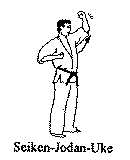 |
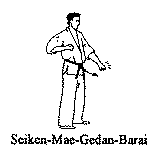 |
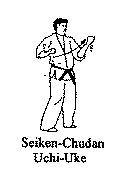 |
| Seiken Jodan Uke | Seiken Mae Gedan Barai | Seiken Chudan Uke |
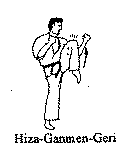 |
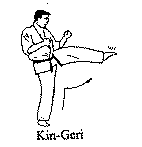 |
| Hiza Ganmen Geri | Kin Geri |
![]()
The Karate Dogi or Gi is the outfit worn for Karate training. It consists of a jacket (uwagi) and trousers (zubon) made of white cotton or canvas and a belt (obi).
The belt worn indicates the rank of the Karateka according to
the standard ranking system adopted in Kyokushin Karate. The ten lower ranks (Mudansha)
of Kyu or non-black belt holders are divided into the following colors: White,
Orange, Blue, Yellow, Green and Brown. The upper ten ranks (Yudansha) of Dan
have the holders wearing the Black Belt. (See belt
rankings.) Although one washes ones gi, the belt is never washed. Every
class that you take, every drop of sweat, every little tear or abrasion is part
of what goes into each student's unique experience. It is something to be
remembered, but not clung to. Therefore no experience is washed away. The belt
must tell its own story.
How to Tie the Obi
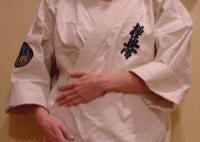 |
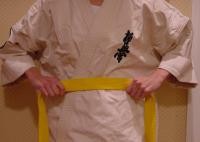 |
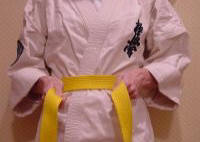 |
| Place the left side of the gi over the right side. | Put the middle of the belt against the navel. | Wrap the belt around the body, from front to back, crossing in the back. |
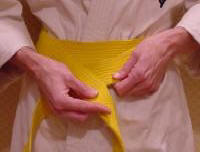 |
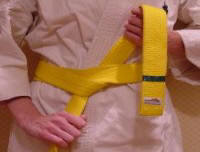 |
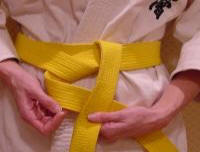 |
| Lay the right end of the belt over the left side. | Bring the right end up behind both layers of the belt wrapped around the body | Cross the left end of the belt over the right, forming a loop |
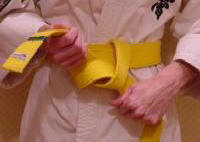 |
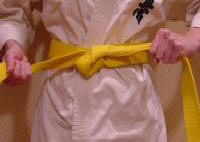 |
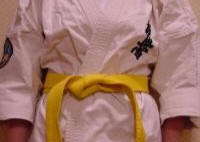 |
| Thread the top end up through the bottom of the loop | Pull tight both sides of the belt at the same time | The finished belt. Both end of the belt should have the same length |
|
|
No Kyu |
White Belt | |||||||
|
No Kyu |
White Belt with Orange stripe | ||||||||
| 10th Kyu | Orange Belt | ||||||||
| 9th Kyu | Orange Belt with Blue stripe | ||||||||
| 8th Kyu | Blue Belt | ||||||||
| 7th Kyu | Blue Belt with Yellow stripe | ||||||||
|
|
6th Kyu | Yellow Belt | |||||||
| 5th Kyu | Yellow Belt with Green stripe | ||||||||
| 4th Kyu | Green Belt | ||||||||
| 3rd Kyu | Green Belt with Brown stripe | ||||||||
| 2nd Kyu | Brown Belt | ||||||||
| 1st Kyu | Brown Belt with Black stripe | ||||||||
| Shodan | Black Belt beginner grade (Senpai grade) | ||||||||
| Nidan | Black Belt 2nd degree (Senpai grade) | ||||||||
| Sandan | Black Belt 3rd degree (Sensei grade) |
![]()
GO TO THE MAIN PAGE OF WINNIPEG KYOKUSHIN KARATE - DOJO ENTHEOS